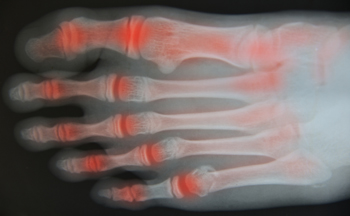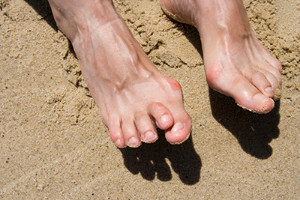Items filtered by date: September 2023
Foot Pain May Indicate Arthritis

When it comes to foot pain, it's important to recognize that it can be more than just a temporary inconvenience. In fact, in many cases, foot pain might be an early sign of arthritis. This widespread condition affects millions of people worldwide, and it can have a profound effect on various joints throughout the body, including those in the feet. One of the most prevalent forms of arthritis that affects the feet is osteoarthritis. This condition develops as the cartilage cushioning the joints wears down over time, leading to persistent pain, stiffness, and swelling. Another type, rheumatoid arthritis, is an autoimmune disorder that can also target the foot joints, resulting in discomfort and deformities. It is important not to ignore foot pain, as it might be your body's early warning signal for an underlying arthritis condition. If you're experiencing persistent foot pain, especially in the morning or after periods of inactivity, it's suggested that you make an appointment with a podiatrist for a comprehensive examination, necessary diagnostic tests, and a tailored treatment plan to manage your symptoms effectively.
Arthritis can be a difficult condition to live with. If you are seeking treatment, contact Gary J. Kaiserman, DPM from Achilles Footcare Center. Our doctor can provide the care you need to keep you pain-free and on your feet.
Arthritic Foot Care
Arthritis is a term that is commonly used to describe joint pain. The condition itself can occur to anyone of any age, race, or gender, and there are over 100 types of it. Nevertheless, arthritis is more commonly found in women compared to men, and it is also more prevalent in those who are overweight. The causes of arthritis vary depending on which type of arthritis you have. Osteoarthritis for example, is often caused by injury, while rheumatoid arthritis is caused by a misdirected immune system.
Symptoms
- Swelling
- Pain
- Stiffness
- Decreased Range of Motion
Arthritic symptoms range in severity, and they may come and go. Some symptoms stay the same for several years but could potentially get worse with time. Severe cases of arthritis can prevent its sufferers from performing daily activities and make walking difficult.
Risk Factors
- Occupation – Occupations requiring repetitive knee movements have been linked to osteoarthritis
- Obesity – Excess weight can contribute to osteoarthritis development
- Infection – Microbial agents can infect the joints and trigger arthritis
- Joint Injuries – Damage to joints may lead to osteoarthritis
- Age – Risk increases with age
- Gender –Most types are more common in women
- Genetics – Arthritis can be hereditary
If you suspect your arthritis is affecting your feet, it is crucial that you see a podiatrist immediately. Your doctor will be able to address your specific case and help you decide which treatment method is best for you.
If you have any questions, please feel free to contact our offices located in Forest Lane and West Kiest Boulevard Dallas, TX . We offer the newest diagnostic and treatment technologies for all your foot care needs.
Reducing Plantar Fasciitis Foot Pain

Plantar fasciitis is a common and painful condition that affects the heel and bottom of the foot. It occurs when the plantar fascia, a thick band of tissue that supports the arch of the foot, becomes inflamed or damaged. The pain from plantar fasciitis can be excruciating and debilitating, making simple tasks like walking a challenge. However, there are ways to reduce this pain and improve your quality of life. Included are stretching exercises for the calf muscles and Achilles tendon, custom or over-the-counter orthotic inserts to improve arch support and provide ample cushioning, and avoiding high heels and flip-flops. Other methods to decrease pain from plantar fasciitis are taking anti-inflammatory medications and using night splints to keep the foot in a dorsiflexed position, which helps stretch the plantar fascia during sleep. More advanced measures include corticosteroid injections to reduce inflammation and shockwave therapy, which stimulates healing in the plantar fascia. In rare cases, surgical intervention may be considered. If you are suffering from plantar fasciitis pain, it is suggested that you make an appointment with a podiatrist for treatment options that are right for you.
Plantar fasciitis can be very painful and inconvenient. If you are experiencing heel pain or symptoms of plantar fasciitis, contact Gary J. Kaiserman, DPM from Achilles Footcare Center. Our doctor can provide the care you need to keep you pain-free and on your feet.
What Is Plantar Fasciitis?
Plantar fasciitis is the inflammation of the thick band of tissue that runs along the bottom of your foot, known as the plantar fascia, and causes mild to severe heel pain.
What Causes Plantar Fasciitis?
- Excessive running
- Non-supportive shoes
- Overpronation
- Repeated stretching and tearing of the plantar fascia
How Can It Be Treated?
- Conservative measures – anti-inflammatories, ice packs, stretching exercises, physical therapy, orthotic devices
- Shockwave therapy – sound waves are sent to the affected area to facilitate healing and are usually used for chronic cases of plantar fasciitis
- Surgery – usually only used as a last resort when all else fails. The plantar fascia can be surgically detached from the heel
While very treatable, plantar fasciitis is definitely not something that should be ignored. Especially in severe cases, speaking to your doctor right away is highly recommended to avoid complications and severe heel pain. Your podiatrist can work with you to provide the appropriate treatment options tailored to your condition.
If you have any questions please feel free to contact our offices located in Forest Lane and West Kiest Boulevard Dallas, TX . We offer the newest diagnostic and treatment technologies for all your foot and ankle needs.
Reminder: When Was the Last Time...?
Conditions Associated With Hammertoe

Hammertoe, claw toe, and mallet toe are related toe deformities that affect the small toes, impacting walking and balance. These deformities result when the pressure on the toes exceeds their joint strength, often due to weak joints, muscle imbalances, or tissue weakness in the lower part of the toe joint. Claw toe involves upward bending of the toe joint at the ball of the foot, with the middle and sometimes end joint curving downward, resembling a claw. It can affect any toes except the big toe. With hammertoe, the toe bends at the middle joint, creating a curled appearance. Hammertoe most commonly affects the second toe, and it often coexists with bunions. Mallet toe is similar to hammertoe but involves the last joint rather than the knuckle joint, resulting in a mallet-like appearance at the end of the toe. Causes of these conditions include wearing ill fitting shoes, high arches, and genetics. Additionally, arthritis, diabetes, tendon imbalances, and neurological conditions can be a cause of developing hammertoe. Treatment options range from padding, orthotic devices, and wearing proper footwear to surgical interventions, including tendon release, joint adjustments, and bone modifications. Surgery is considered when non-operative methods fail to alleviate pain or correct the deformity. If you have toe problems or pain, it is suggested that you make an appointment with a podiatrist for a proper diagnosis and treatment right for you.
Hammertoes can be a painful condition to live with. For more information, contact Gary J. Kaiserman, DPM of Achilles Footcare Center. Our doctor will answer any of your foot- and ankle-related questions.
Hammertoe
Hammertoe is a foot deformity that occurs due to an imbalance in the muscles, tendons, or ligaments that normally hold the toe straight. It can be caused by the type of shoes you wear, your foot structure, trauma, and certain disease processes.
Symptoms
- Painful and/or difficult toe movement
- Swelling
- Joint stiffness
- Calluses/Corns
- Physical deformity
Risk Factors
- Age – The risk of hammertoe increases with age
- Sex – Women are more likely to have hammertoe compared to men
- Toe Length – You are more likely to develop hammertoe if your second toe is longer than your big toe
- Certain Diseases – Arthritis and diabetes may make you more likely to develop hammertoe
Treatment
If you have hammertoe, you should change into a more comfortable shoe that provides enough room for your toes. Exercises such as picking up marbles may strengthen and stretch your toe muscles. Nevertheless, it is important to seek assistance from a podiatrist in order to determine the severity of your hammertoe and see which treatment option will work best for you.
If you have any questions, please feel free to contact our offices located in Forest Lane and West Kiest Boulevard Dallas, TX . We offer the newest diagnostic and treatment technologies for all your foot care needs.
Complications of Cracked Heels

Cracks in the heels occur due to damage to the skin's protective outer layer. This layer normally retains moisture in the skin through natural oils. However, when this barrier is compromised by things like ill-fitting shoes, harsh weather, or an inadequate diet, moisture escapes. Consequently, the skin becomes dry, brittle, and rigid. Over time, the pressure of one’s body weight causes the skin to split and bleed, resulting in varying sizes and depths of cracks. The discomfort associated with cracked heels stems from the exposure of sensitive lower skin layers, easily irritated by the environment, and prone to snagging on socks or clothing. While cracked heels are primarily a cosmetic concern, in severe cases, deep cracks that bleed can raise the risk of infection. This is particularly concerning for individuals with underlying medical conditions like diabetes, where severe skin damage or infection is a higher risk. To alleviate the pain of cracked heels, rehydration to restore the skin's protective barrier is key. Applying moisturizer daily and cushioning the feet with comfortable shoes and padded insoles can aid in the healing process. If you suffer from persistent or worsening cracked heels, it is suggested that you make an appointment with a podiatrist for treatment.
Cracked heels are unsightly and can cause further damage to your shoes and feet. If you have any concerns, contact Gary J. Kaiserman, DPM from Achilles Footcare Center. Our doctor can provide the care you need to keep you pain-free and on your feet.
Cracked Heels
Cracked heels appear unappealing and can make it harder for you walk around in sandals. Aside from looking unpleasant, cracked heels can also tear stockings, socks, and wear out your shoes. There are several methods to help restore a cracked heel and prevent further damage.
How Do You Get Them?
Dry skin is the number one culprit in creating cracked heels. Many athletes, walkers, joggers, and even swimmers suffer from cracked heels. Age and skin oil production play a role to getting cracked heels as well.
Promote Healing
Over the counter medicines can help, especially for those that need instant relief or who suffer from chronic dry feet.
Wear Socks – Wearing socks with medicated creams helps lock in moisture.
Moisturizers – Applying both day and night will help alleviate dryness which causes cracking.
Pumice Stones – These exfoliate and remove dead skin, which allows for smoother moisturizer application and better absorption into the skin.
Change in Diet
Eating healthy with a well-balanced diet will give the skin a fresh and radiant look. Your body responds to the kinds of food you ingest. Omega-3 fatty acids and zinc supplements can also revitalize skin tissue.
Most importantly, seek professional help if unsure how to proceed in treating cracked heels. A podiatrist will help you with any questions or information needed.
If you have any questions, please feel free to contact our offices located in Forest Lane and West Kiest Boulevard Dallas, TX . We offer the newest diagnostic and treatment technologies for all your foot care needs.

